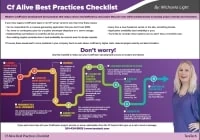Some of you may have read the Computer World article listing ColdFusion as one of 10 dead languages and Ben Forta's response, Ray's opinions and Adam's rant on this. Obviously ColdFusion is not dying but how do you convice your clients that CF is the right solution? I am giving a talk at CFUNITED-07 on “Selling ColdFusion to Clients” that will cover what strategies to use for selling ColdFusion to clients and how to deal with common objections that clients have.
People have been telling me what arguments have been working on the street.
Here are the partial results to date on this. I will give the full results at CFUNITED
What issues have you heard when selling a ColdFusion solution to clients?
- Cost of CF server 83%
- Not made by Microsoft 41%
- CF slow 33%
- Not a real language 33%
- Not Object Oriented 25%
- Not secure 25%
- Other 33%
What arguements have you made for using ColdFusion on a project?
- Rapid development 91%
- Easy to maintain code 66%
- Made by Adobe 75%
- 11 years old 66%
- Lots of built in functions 66%
- Open standards 25%
- Multiple vendor support 25%
- Other 8%
And to continue learning how to make your ColdFusion apps more modern and alive, I encourage you to download our free ColdFusion Alive Best Practices Checklist.
Because… perhaps you are responsible for a mission-critical or revenue-generating CF application that you don’t trust 100%, where implementing new features is a painful ad-hoc process with slow turnaround even for simple requests.
What if you have no contingency plan for a sudden developer departure or a server outage? Perhaps every time a new freelancer works on your site, something breaks. Or your application availability, security, and reliability are poor.
And if you are depending on ColdFusion for your job, then you can’t afford to let your CF development methods die on the vine.
You’re making a high-stakes bet that everything is going to be OK using the same old app creation ways in that one language — forever.
All it would take is for your fellow CF developer to quit or for your CIO to decide to leave the (falsely) perceived sinking ship of CFML and you could lose everything—your project, your hard-won CF skills, and possibly even your job.
Luckily, there are a number of simple, logical steps you can take now to protect yourself from these obvious risks.
No Brainer ColdFusion Best Practices to Ensure You Thrive No Matter What Happens Next
ColdFusion Alive Best Practices Checklist
Modern ColdFusion development best practices that reduce stress, inefficiency, project lifecycle costs while simultaneously increasing project velocity and innovation.
√ Easily create a consistent server architecture across development, testing, and production
√ A modern test environment to prevent bugs from spreading
√ Automated continuous integration tools that work well with CF
√ A portable development environment baked into your codebase… for free!
Learn about these and many more strategies in our free ColdFusion Alive Best Practices Checklist.
